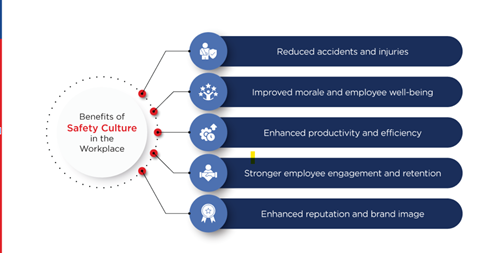10 Practical Steps to Improve Safety Culture at Your Workplace
A positive safety culture not only reduces accidents and injuries but also improves morale, productivity, and overall organisational performance. In this blog, we'll discuss practical ideas to improve safety culture in the workplace, promoting a culture of safety excellence that enhances employee morale and organisational success.

What is Safety Culture at the Workplace?
Safety culture in the workplace refers to the collective attitudes, beliefs, behaviours, and values that employees and management share regarding safety. It encompasses the organisation's commitment to prioritising safety, the way employees perceive and approach safety-related issues, and the extent to which safety is integrated into everyday work practices. A positive safety culture fosters an environment where safety is valued, prioritised, and consistently practised by everyone in the organisation.
Key Benefits of Safety Culture in the Workplace
- Reduced accidents and injuries lead to lower absenteeism and decreased medical costs.
- Improved morale and employee well-being result in higher job satisfaction and increased motivation.
- Enhanced productivity and efficiency contribute to smoother operations and improved workflow.
- Stronger employee engagement and retention foster a positive work environment and lower turnover rates.
- A positive safety culture enhances reputation and brand image, attracting top talent and gaining trust from stakeholders.

10 Practical Steps to Improve Safety Culture at Your Workplace
Here are 10 practical steps to improve safety culture at your workplace, ensuring a safer and healthier environment for all employees:
1. Conduct a Safety Culture Assessment
Before embarking on the journey of improving safety culture, it's essential to conduct an OHS audit to assess the current state of safety culture in your workplace. Gathering feedback from employees through surveys, interviews, and observations provides valuable insights into areas for improvement and opportunities for growth.
2. Leadership Commitment
Leadership plays a pivotal role in promoting a culture of safety. By demonstrating a genuine commitment to safety, leaders set the tone for the organisation and inspire employees to prioritise safety in their daily activities. Leading by example, they initiate a step change in safety culture that permeates throughout the organisation.
3. Assess Current Attitudes Toward Health and Safety
Before implementing any safety culture improvement initiatives, it's crucial to understand the current attitudes and perceptions toward health and safety in the workplace. Conduct surveys or focus groups to assess employees' attitudes, beliefs, and behaviours related to safety. This assessment also provides valuable insights into areas where additional education or communication may be needed to foster a culture of safety excellence.
4. Comprehensive Training
Providing comprehensive safety training equips employees with the knowledge and skills they need to work safely. Through OHS audits, organisations identify training needs and develop tailored training programs that address specific safety concerns. Regular training sessions reinforce key safety messages and promote a culture of continuous improvement.
5. Clear Communication
Clear and transparent communication is essential for promoting a culture of safety excellence. Organisations should establish open channels for employees to report hazards, near misses, and safety concerns without fear of reprisal. Through regular safety meetings and toolbox talks, organisations facilitate open dialogue and reinforce safety protocols.
6. Recognition and Incentives
Recognising and rewarding employees for their contributions to safety is an effective way to promote a positive safety culture. Implementing safety recognition programs and offering incentives for safe behaviours motivates employees to actively participate in safety initiatives. By celebrating safety achievements, organisations reinforce the importance of safety culture excellence.
7. Establish Clear Safety Policies and Procedures
Developing clear and concise safety policies and procedures provides employees with clear guidance on safe work practices. Through OHS audits, organisations identify gaps in existing policies and procedures and implement necessary changes to improve safety culture. Clear communication of policies ensures that employees understand their responsibilities and adhere to safety protocols.
8. Foster a Culture of Continuous Improvement
Creating a culture of continuous improvement is essential for sustaining safety culture excellence. By encouraging employees to provide feedback and suggestions for improvement, organisations foster innovation and creativity in safety initiatives. Regular review and revision of safety practices ensure that safety culture evolves with changing workplace conditions.
9. Regular Evaluation and Monitoring
Regular evaluation and monitoring of safety performance are critical for measuring progress towards safety culture excellence. Through OHS audits and key performance indicators, organisations track safety metrics and identify areas for improvement. By regularly reviewing safety practices, organisations ensure that safety culture remains a top priority.
10. Lead by Example
Finally, leaders must lead by example and consistently demonstrate their commitment to safety. Through their actions and decisions, leaders set the standard for safety culture excellence and inspire employees to prioritise safety. By modelling safe behaviours and actively participating in safety initiatives, leaders can create a culture where safety is everyone's responsibility.
Conclusion
In summary, we can say that through occupational health and safety audits, continuous improvement initiatives, and leadership commitment, organisations can create a safer and healthier work environment for all. By implementing these 10 practical steps and initiating a change in safety culture, organisations can promote a culture of safety excellence that enhances employee well-being and organisational success.
At the British Safety Council, we are dedicated to safeguarding the safety and well-being of employees in their workplaces. Our top offering, 'Five Star Audits,' provides comprehensive support for our clients. These audits rigorously adhere to globally recognised standards, ensuring resolute compliance with stringent health and safety regulations.
Our diverse suite contains audits spanning Environmental Sustainability audits, Occupational Health and Safety audits, Process Safety audits, and more. With our esteemed reputation and unwavering commitment to upholding safety standards, we aim to cultivate a transformative safety culture across organisations.
